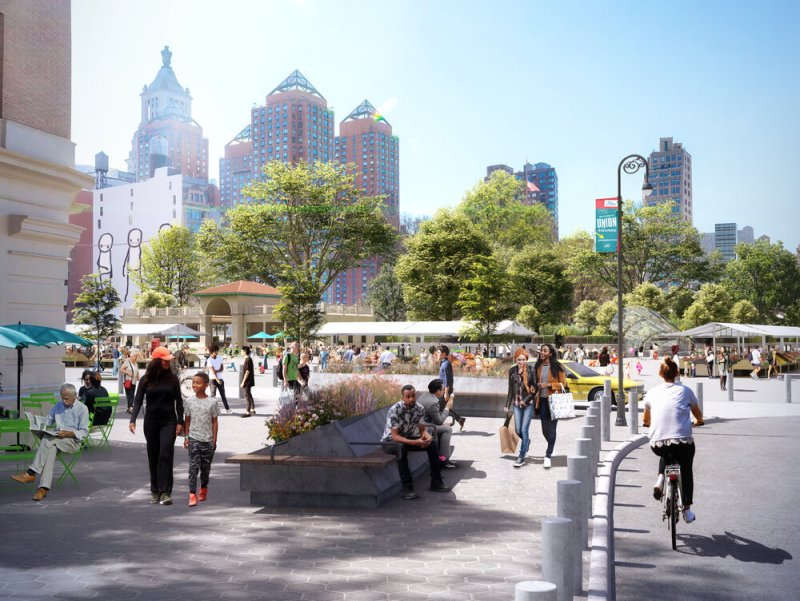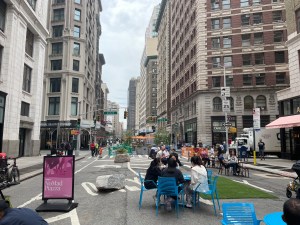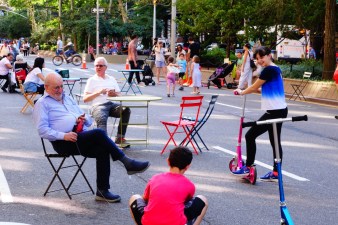Re-Emergence of ‘Broadway Vision’ Plan Startles Some
Pedestrianization at Union Square gains impetus from a business-improvement district — not the DOT.

The de Blasio administration has done very little to speed the pedestrianization of Broadway that started under his predecessor, but nonetheless was very quick to put its own spin on a bold vision put forth for the street by a well-funded business group last week.
The Union Square Partnership had unveiled a $100-million plan to remove cars from the Union Square-14th Street area and create almost 100,000 more square feet of public space. The plan did not come out of the city’s Department of Transportation.
Nonetheless, the DOT’s Manhattan borough commissioner, Ed Pincar, heralded it in a press release, saying it “aligns with DOT’s Broadway Vision plan to complete a [2.5-mile] pedestrianized corridor from Columbus Circle to Union Square.”
Aligns with what now?
Union Square Partnership’s Board Chairs Lynne Brown of @nyuniversity and William Abramson of @BWrealtygroup share their thoughts on the highly anticipated Union Square-14th St. Vision Plan release. Read the full plan here: https://t.co/QPWhfGHfn8 #USQDistrictVision #UnionSquareNY pic.twitter.com/TsOapFgWWl
— Union Square (@UnionSquareNY) January 19, 2021
First, some background: As one of Manhattan’s notorious car sewers, New York’s iconic thoroughfare has figured as the “Holy Grail” of pedestrianized boulevards for safe-streets activists for years. Such advocates have long sought to eliminate cars between Houston Street and Columbia University in Morningside Heights — and enjoyed initial progress under Mayor Bloomberg, when the DOT’s Public Space Unit established a number of shared-street spaces and pedestrian plazas at Times, Herald, Madison and Union squares. The plazas gained a huge following among residents, businesses and tourists and rank among the city’s most popular destinations.
So what has the city done more recently? Baby steps.
A DOT spokeswoman, Lolita Avila, said in an email that since de Blasio has taken office, the DOT had installed “shared streets in the Flatiron District and Union Square” (a reference to roadways where car drivers are permitted, but required to go slowly) and had added a “plaza block” and “upgraded bike facilities in Herald Square” as well as having closed some parts of Broadway in the Garment District temporarily for summer programs.
Activists said that the Flatiron/Union Square shared streets along Broadway from 25th to 23rd amounted to a minor variation on pre-de Blasio arrangements, not a major project; likewise, the Herald Square “plaza block,” which increased pedestrian space on Broadway between 32nd and 33rd streets, merely refreshed the Bloomberg-era plaza in 2019. The upgraded routing for bikes through Herald Square drew high marks.
The DOT did present an overview of its strategy for a “pedestrian friendly” Broadway between Columbus Circle and Union Square to Manhattan Community Board 5 on Jan. 27, 2020 — a few weeks after de Blasio’s sixth anniversary as mayor. The presentation outlined a “toolkit” consisting of “slow blocks,” “shared streets,” and “base blocks” and suggested some “possible configurations,” but promised workshops and follow-up meetings never happened, likely due to the pandemic. Even if they had, check the sell-by date: It is now January, 2021, or more than seven years after Mayor de Blasio took office. He has less than a year to burnish his legacy.
“We are working closely with all our partners to develop several projects that we plan to roll out in 2021, 2022, and beyond,” Avila said.
In 2022, when de Blasio is no longer mayor?
The city’s inaction on Broadway long has irked pedestrian and street-safety activists.
Union Square Partnership’s Board Chairs Lynne Brown of @nyuniversity and William Abramson of @BWrealtygroup share their thoughts on the highly anticipated Union Square-14th St. Vision Plan release. Read the full plan here: https://t.co/QPWhfGHfn8 #USQDistrictVision #UnionSquareNY pic.twitter.com/TsOapFgWWl
— Union Square (@UnionSquareNY) January 19, 2021
“I am frustrated with their lack of follow-through to make this vision a reality,” said Katherine Nessel, who is leading Transportation Alternatives’ Car-Free Broadway campaign. “The Open Broadway plan was delayed from March through early Fall due to COVID-19, when this would have been the perfect time to move forward given the need for more social distancing space and the lack of car traffic along the corridor. I am hopeful progress will be made this spring and summer, but the dismal track record the administration has on completing other street redesigns like the Fifth Avenue busway means that they will need to be pressured and held accountable to move forward in a timely manner.”
Christine Berthet, founder of the pedestrian-advocacy group CHECKPEDS, praised the Union Square Partnership plan for what it could add to a pedestrianized Broadway. “Having a long green path to cross the city north to south is a dream for pedestrians,” she said. “Just like we have highways to connect cities, it would connect neighborhoods and encourage many New Yorkers to mingle and walk more in a safe and green environment.”
But Berthet lamented that New York lacked the vision of Paris, which even now is replacing the pavement of its iconic boulevard with green space. “When you see the plans announced by Paris’s mayor to transform the Champs-Élysées into a park, you wonder why there is still any asphalt on Broadway,” she said.
Others rued the time city has lost — basically, a prosperous decade — because of the mayor’s inaction.
“We have been working for years on this issue and the city has come up with nothing that I am aware of,” said Howard Yaruss, among a group of Upper West Side activists who have pushed for the pedestrianization of Broadway from 73rd to 79th streets. “‘Stalled’ is an understatement. ‘Absent’ seems like a more appropriate word.”
Still others wondered why such initiatives for car-free public space seem constantly to be coming from wealthy business-improvement districts, which represent corporate interests first and foremost: The fact that the city seeks outside sponsors for even the smallest street improvements, such as bike corrals and neckdowns, long has hampered its ability to accomplish anything, many activists have said.
“Until the city sets up a framework that empowers locals to solve their issues and set their neighborhood priorities, we rely on BIDs and corporate sponsors to lead these conversations and public-space improvements,” said Lisa Orman, a moving force behind City Rise, a campaign to empower New Yorkers to transform streets and fuel the post-COVID recovery. (Full disclosure: Streetsblog has the same parent company.) “Those who live or work (or visit) near Union Square are fortunate to have such a forward-thinking group who cares about public gathering, accessible transit, and beautifying this iconic city gem.”
The lack of progress on Broadway Vision during this mayoralty stems from a more general lack of vision, some said.
“The bigger issue is that the de Blasio administration has no programs/policies for public space, so DOT is left tinkering around the edges,” said Jon Orcutt, the communications and advocacy director of Bike New York, who directed policy at the DOT under Bloomberg.
The absence of current public information on Broadway on the DOT website testifies to the administration’s apparent inaction; the DOT’s Broadway webpage itself touts improvements from 2010 and 2012 and still refers to “Mayor Bloomberg.” (Update: After initial publication of this story, DOT fixed that. The agency also referred Streetsblog readers to the “Current projects” page, where the 2020 Broadway Vision presentation can be found; the agency also asked readers to click on prior calendar years for other Broadway-focused street improvement projects. We did that — and found the projects the DOT spokeswoman had indeed referenced higher up in this story. To make a complete picture, we can also point out that the agency has done additional projects on the lower parts of Broadway, but those are not part of the “Broadway Vision” referenced by Pincar and the Union Square Partnership, which form the basis for this story about the lack of cohesive, decisive action to pedestrianize Broadway through Midtown.)



